Table of Contents
If you thought email marketing for nonprofits is obsolete in this age of social media, think again.
A study shows that nonprofits that engage in email marketing:
- See higher engagement with key supporters
- Larger gift sizes
- Increased levels of participation from volunteers.
With the pandemic restricting movement, email marketing becomes all the more important for nonprofits. Instead of letting COVID-19 set them back in time, nonprofits have increased email communication by 62%!
Let us look at the best practices and tools you can utilize to get the most out of email marketing for your nonprofit.
Why is email marketing for nonprofits important?
Marketing campaigns bring in volunteers, donors, and funds to sustain a nonprofit’s cause. To ensure your appeals don’t get lost in the void, you need to:
- Utilize channels that people prefer to discover nonprofits
- Use messages that appeal to them
- Engage in channels that people prefer to communicate with nonprofits (which may be the same or different from how they found you).
Email marketing for nonprofits checks these boxes. Let’s have a look at why:
Why email:
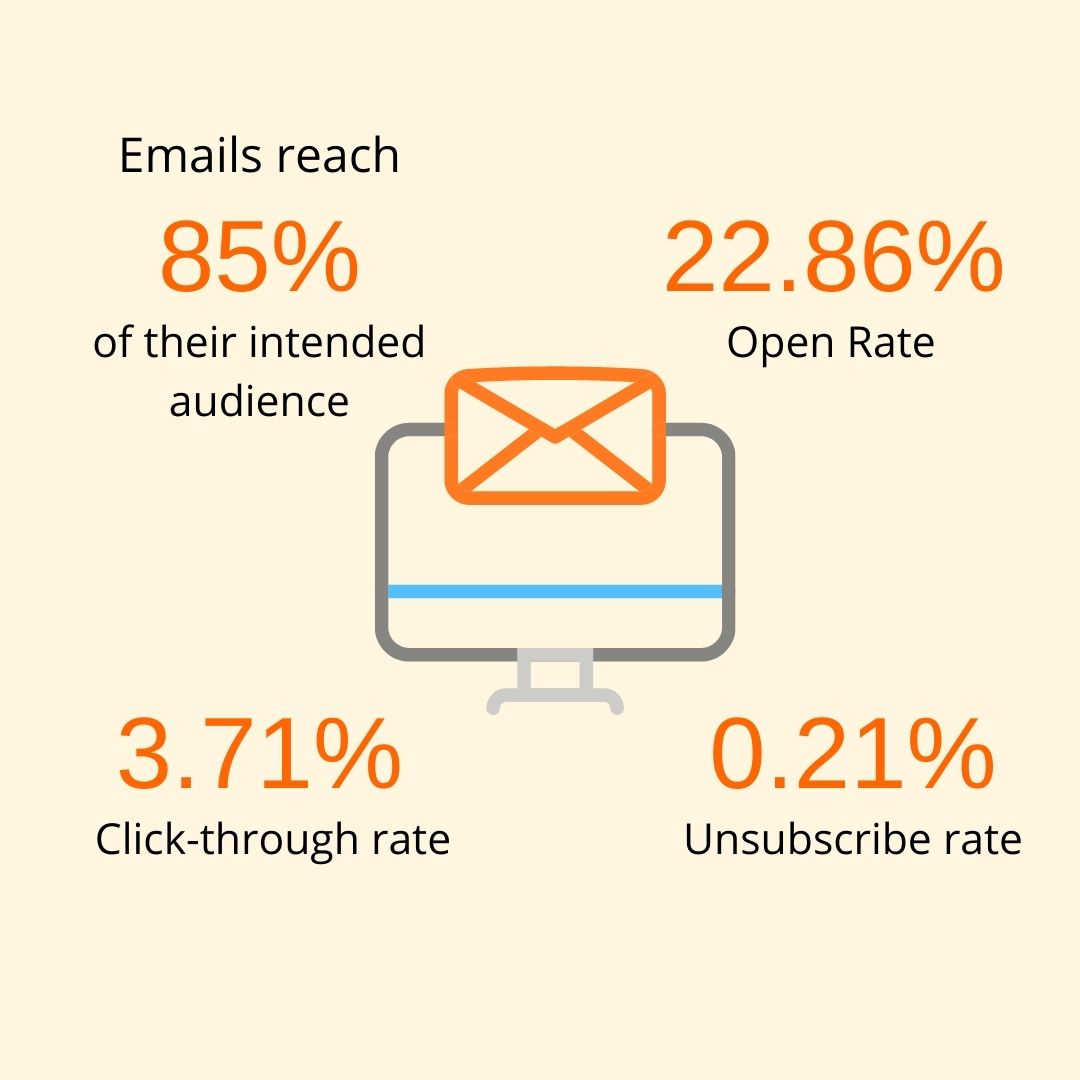
1. Discoverability: A study by Campaign Monitor showed that when it comes to online methods,
- 39.5% of respondents said they discovered the nonprofit of their choice on Facebook
- 27.5% said online research
- 22.3% said emails and
- 19.8% said Instagram.
Social media and online research require some initiative from people.
- They will have to put in the effort to search for your cause (on Google) and even then you will need to make sure that you rank above your competitors.
- Their connections should be actively engaging with your content for it to appear on their feed.
- Their locations, interests, and search history must be similar to yours for your content to come up in their recommendations, and that is not always likely.
On the other hand, email marketing for nonprofits is your initiative and involves approaching potential supporters proactively.
2. Preferred mode of communication: About 42% of respondents in the Campaign Monitor study said that they prefer nonprofits to send emails for communication.
3. Drives donations: In 2017, 28% of all online nonprofit revenue was generated by email marketing for nonprofits.
why email marketing for nonprofits:
Now it’s very well to use emails to communicate with your nonprofit’s supporters. But why must you drive marketing through this channel?
Good email marketing for nonprofits or charities can:
- Expand the base of recurring donors by taking them through a good nurturing flow
- Nurture new donors or volunteers to retain them and get them more involved with the organization
- Widen your reach within the community by sharing news and updates about your campaigns and encouraging participants to share them.
- Help you raise funds when you make donation appeals in your emails and add prominent, user-friendly donation links/buttons.
| How often should nonprofits send emails? The average nonprofit sends 59 emails per year. Is that too much or too little for your audience? Too few emails can make your nonprofit obsolete. Too many marketing emails can be exhausting. But how to walk the fine line between the two? Let your audience decide. Your supporters can determine your ideal frequency to send emails. ◙ Add options for the nature and frequency of correspondence in your sign-up form. Or, ◙ When they sign up to join your mailing list, ask them what they would like to see and how frequently in the welcome email. Save the choices and follow through. Or, ◙ Run A/B tests to see what kind of email marketing works for your nonprofit and how often your audience prefers to receive your emails. (For eg., start with sending one email per week to your supporters. Split the group into two and start sending two emails per week to one group and one to the other. If you see an increase in unsubscribe rates or a drop in open/read rates in the first group, you may have to dial the frequency down to once/week. If you don’t see negative results, you can increase the rate to three/week for one group and two/week for the other and keep track of it. Repeat the same with images, CTAs, subject lines etc.) The ideal frequency of email marketing for nonprofits or charities boils down to two points: 1. How often do you have relevant and valuable information to share 2. How often your audience prefers to receive this information |
Email marketing for nonprofits: best practices
The average person receives well over 121 emails daily! These also include business correspondence. But how does your nonprofit stand out from the chaos of an inbox? Here are some best practices you can adopt.
1. Build and segment your email list
In 2019, nonprofits reported an 8% decline in fundraising from email despite having an extensive email list.
So it is not about the number of emails you shoot into an inbox. The quality determines the success of your nonprofit marketing. List building for nonprofits is thus an essential prerequisite for a successful email marketing campaign.
Avoid buying lists, instead try to encourage people to sign up for the email list through pop-ups, sign-up forms across your website. This gives you a list of relevant leads who are genuinely interested in your content and would actually want to receive emails.
When you have a good email list, the next step is to segment it. Categorize your supporters into different segments (Donors/volunteers, prefer updates Vs. prefer stories, engagement) and stitch different email campaigns suitable for each segment.
Personalize. According to a study by Accenture, 44% of donors are willing to give 10% more donations if they can get a personalized experience in return. Addressing the donor by name, mentioning their donation history and the impact it created, etc. are small personal additions but go a long way.
2. Diversify your emails
Your supporters should feel a sense of belonging when communicating with you. You cannot bombard them only with donation appeals.
Good email marketing for nonprofit organizations includes a mix of:
- Updates and reports
- Donation appeals
- Volunteering opportunities
- Feedback, surveys, and questionnaires
- Newsletters
- Donor recognition messages
- Incentives (gift vouchers, coupons, etc.)
- Beneficiary stories and donor testimonials
You can shuffle the order according to your audience’s preference and your insights.
3. Make requests that resonate with the level of engagement
Consider this. You are at an art gallery, admiring this beautiful sculpture when a man introduced himself as a patron for struggling artists. You appreciate this, but the person asks you to join him with a contribution right away.
There was no opportunity to check his past work, impact, and build trust. You are most likely to decline this request.
The same goes for email marketing for nonprofits.
Your marketing emails must resonate with the level of engagement of your supporters. When a person has just joined your email list, start with building trust, and gradually climb up the ladder of engagement.
- Include impact stories and ask them to follow your social media handles for more updates.
- When they start following your accounts, ask them to share your stories on their social feed.
- Those who frequently engage with you on your social media show a higher level of trust. Ask them to donate a small amount.
- New donors can then be turned into recurring donors.
- You can then request donors to volunteer or to increase gift size.
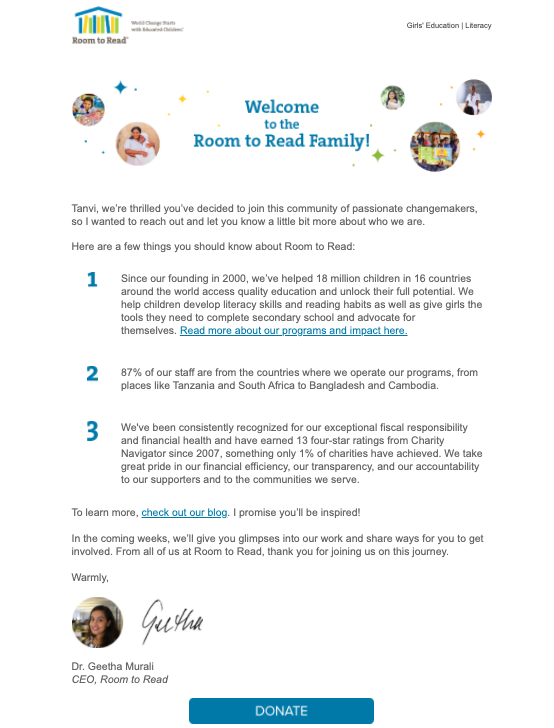
A welcome email by Room to Read, complete with an introduction, personalization, link to the domain, and CTA.It includes a link to a specific page (programs and impact) for readers on lower steps of the ladder of engagement.
For those with more engagement, the mail has a link to their blog (for further resources and readings)
And for those who already trust the organization, they have included a donate button at the end.
4. Craft compelling email copy
When it comes to email marketing, content is king. Here’s a cheat sheet for a strong email:
- Strong subject line: KellyAnn Romanych, member of the Forbes Nonprofit Council, suggests, “Write clear subject lines that reflect their aspirations and use the strongest verbs you can find. Be clear over clever, so your message resonates, especially if your organization offers more than one impactful service.”
- Personal, purposeful stories: As a nonprofit, you are surrounded by stories of distress, impact, and hope. Share them with your supporters via emails.
- Compelling CTA: Follow the stories with a persuasive call-to-action. If your stories grip them, a CTA will turn it into an inspiration to be part of your movement.
- Add visuals: Images in emails can increase click-through-rates by 42%, and videos increase CTR by 65%.
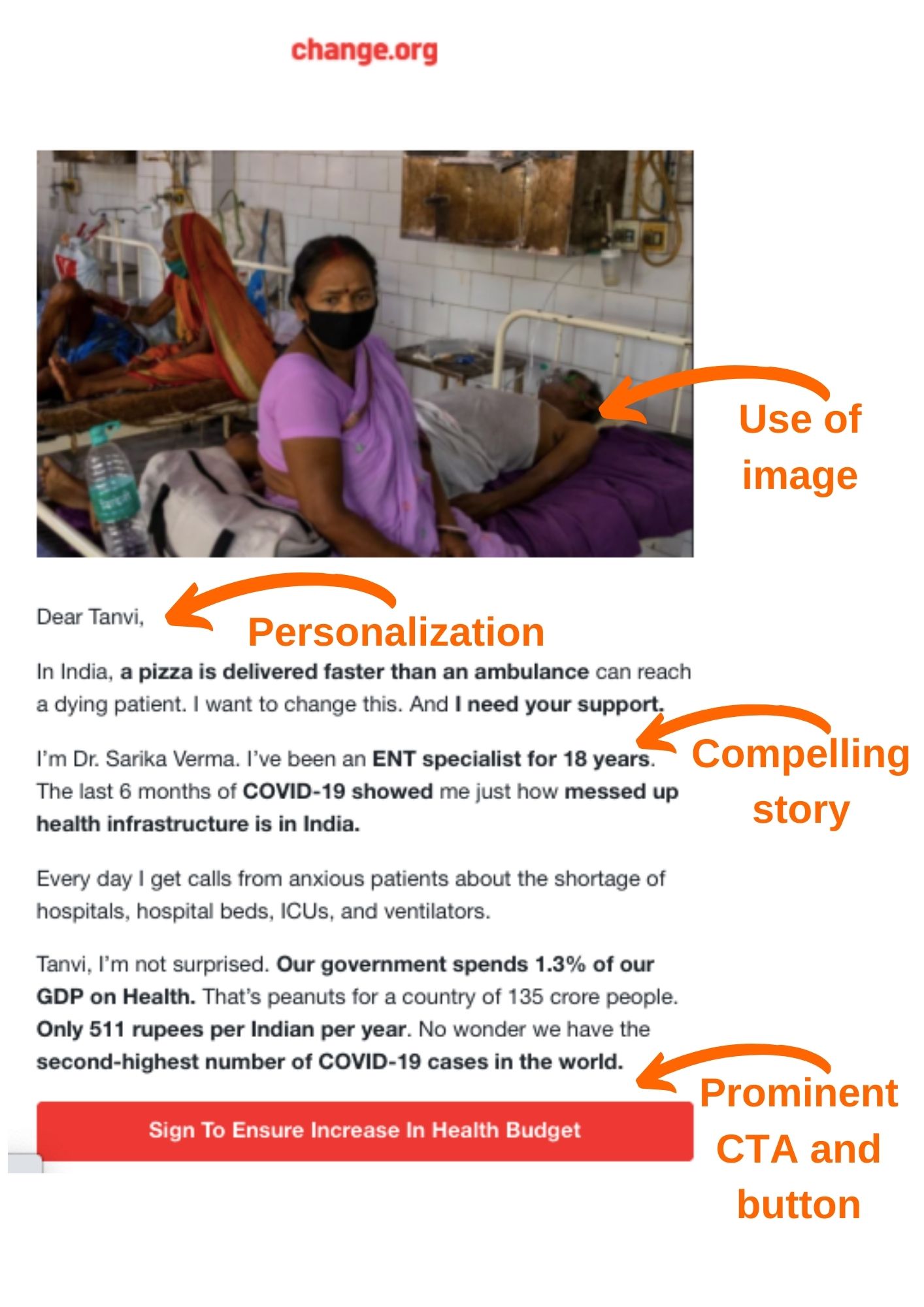
5. Ensure your emails have a mobile-optimized design
46% of emails are opened on mobile phones. Design your emails in a manner that is mobile-friendly so people can read them on the go.
- Write short subject lines (mobiles replace part of long subject lines with ellipses (…).
- Use a single font. Use bold, italics, or different colors, only to highlight.
- Add prominent, clickable donation or sign-up buttons in the email body to keep the attention alive.
- Use clear but medium-sized images. Large images are not mobile-friendly.
- Make sure that the CTA leads to a mobile-optimized page for a graceful user experience.
6. Track insights and evolve strategies accordingly
A good nonprofit marketing plan involves tracking insights and trends as they happen. If a specific nonprofit email marketing strategy shows encouraging trends, you continue with it. If the results are unsatisfactory, you experiment with a new tactic.
Insights on email marketing for nonprofits involves tracking the following (and in this order):

7. Use social media along with email
We have seen previously that social media enables a substantial number of people to discover nonprofits. Combining the reach of social media with emails can help you widen your reach without spending a bomb.
- Share opt-in options on your social media handle, to get your followers to subscribe to your emails
- Ask current email subscribers to follow you on social media as the first step on your ladder of engagement. Add social media handles and sharing buttons in your emails to encourage them to do so.
- Use Facebook, Instagram, Youtube, and other social media to run fundraising campaigns. Share them via email with existing donors.

Related Reading: Social Media Fundraising: The All-in-one Guide
| How to stay away from the spam folder: ◙ Get explicit or implicit permission before sending emails (opt-ins are explicit consent; existing members, donors, or volunteers can count as tacit permissions). ◙ Stay updated with the laws about email marketing for nonprofits in your country. (Canada follows their Anti-spam legislation, EU follows GDR regulations, USA has the CAN-SPAM Act). ◙ Send emails from IDs of employees (with your nonprofit’s name as the domain) rather than “no-reply” emails. ◙ Set up an automated welcome email that tells subscribers what to expect and allows them to choose the nature and frequency of emails. ◙ Don’t send too many emails. It can get exhaustive. An average of one email per week is healthy. You can amp them up during holidays or special occasions. |
Types of email marketing for nonprofits that work like a charm:
| Type of message | Best practices |
| Welcome message | – Set the trigger to automatically send this email as soon as someone signs up – Personalize – Add a form for (or link to) a preference center to allow subscribers to choose how and how frequently they want to receive your messages. |
| Beneficiary or donor stories | – Include personal accounts wherever possible – Recruit writers (or get volunteers) who can create compelling stories for outreach and donation appeals – Supercharge your story with visuals |
| Surveys | – Add short surveys (star rating, yes/no questions, ranked preferences) in your emails to understand a new audience – Add a detailed questionnaire for people who have engaged with you before – Ask for feedback from audiences on all levels of engagement to get them more invested in your organization. |
| Update emails | – Send updates to supporters who have volunteered or donated for your nonprofit – Emails allow you to send detailed messages with visuals, weblinks, and more. Utilize them. – Make sure you send at least one update email to participants of a campaign. – Back your records, updates, and appeals with numbers and statistics. |
| Thank-you message | – A thank you message should be different from an update email. This one is specifically for supporter, donor recognition, or volunteer appreciation. – Personalize with the name, amount donated, how it helped, etc.. – Include receipts, special requests, etc. wherever applicable. – Add images, videos, or personal testimonials. |
| Holiday emails | – Holidays are a busy time for nonprofits in terms of volunteers and donors. Remember to send marketing emails on all relevant holidays. – Segment your holiday email lists (sort by faith, nationality, profession, etc.) |
| Event invitation | – Event invitations have a high response rate. Use them to drive donations and volunteer sign-ups. – Enable instant sign-ups, table purchasing, ticket purchasing in the event invitation emails. Set triggers in your email marketing tool to send reminders or donation appeals to people who do not register for the event. – Be transparent about the nature of the event, whether the tickets are free, and your expectations. – Provide details like the number of available seats, directions, what to bring, etc. in the event invite rather than waiting for people to sign-up first. |
| Donation appeals | – Share a purposeful, moving story. – Give a clear and compelling CTA. – Provide a prominent donation button/link. Use online donation tools that make giving easy. – Include statistics and numbers in relevant and strategic positions (eg., highlight the numbers when they show a considerable impact) |
| Volunteer email | – Provide all details about the opportunity, date(s), location in the marketing email – Include ways of communication (replying to the email may not be possible. Add social media handles, alternate email ID, or phone number in your message.) – Be courteous. – Provide the contact person’s name and contact details, so your email looks credible. |
8 best software in email marketing for nonprofits
To ensure your email marketing goes smoothly and gets desired results, you need reliable and effective tools. Here are eight nonprofit email marketing tools you can use:
Intuit Mailchimp

Notable Features:
- Create custom sign-up forms with relevant fields you need for personalized, high-quality emails. Add the forms as popovers, embeds, or shareables.
- Add triggers for automated messages. Intuit Mailchimp’s sophisticated AI personalizes the automated messages.
- Pave customer journeys to send relevant messages to the segmented audiences automatically.
- Undertake A/B tests, learn from Mailchimp’s database, track sales, audience growth, purchase likelihood, and more.
Active Campaign
Notable Features:
- Broadcast emails to give shout-outs to all contacts. Follow them with triggered emails for those who open and respond. Email autoresponders ensure your supporters get a reply, always.
- Email automation in Active Campaign guides you in nurturing new leads, so they turn into loyal supporters.
- Test your subject lines, content, CTA, images, and sender info to optimize email marketing for your nonprofit.
- 20% discount for registered nonprofits.
Campaign Monitor
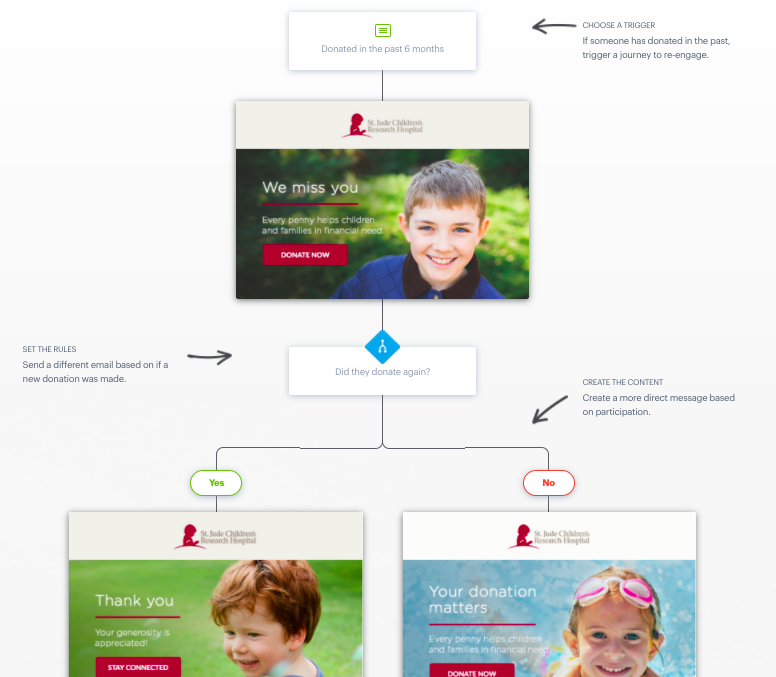
Notable Features:
- Campaign Monitor is an email-creation tool for nonprofits that do not have professional writers or graphic designers on the team. You can choose from pre-designed templates to quickly compose an email.
- Set automated emails to welcome new subscribers, send reminders, share offers, and more. Create customer journeys to retain new customers, nurture existing ones, and bring back potential attritions.
- The email marketing tool offers a 15% discounted price for 501(c)(3) nonprofits.
Benchmark for email marketing in nonprofits
Notable Features:
- Benchmark offers RSS emails for nonprofits without code developers. For teams that prefer more customizations, they have an HTML editor too.
- Email marketing is often full of experiments- right from subject lines to the CTA. The tool offers A/B testing options and insights to track what works for your audience.
- Their contact database, list verification feature and white labeling let you send branded emails to high-quality contacts.
- For beginners, Benchmark has a step-by-step practical guide to teach you the basics of email marketing for nonprofits.
Vertical Response
Notable Features:
- Automated follow-up emails that help you increase reach and improve open-rates. Set a date, time, and a new subject line to resend emails to those who did not open the first one.
- Some people prefer reading emails in the morning. Others, when they are returning home in the evening. Track such behavior and set up an automated email series for varying audience segments.
- Integrations with CRMs like SugarCRM and Salesforce help you sync your contacts and build your email marketing upon them.
- Vertical Response offers 50% off on any PRO monthly subscription for 501(c)(3) nonprofit organizations.
SendX
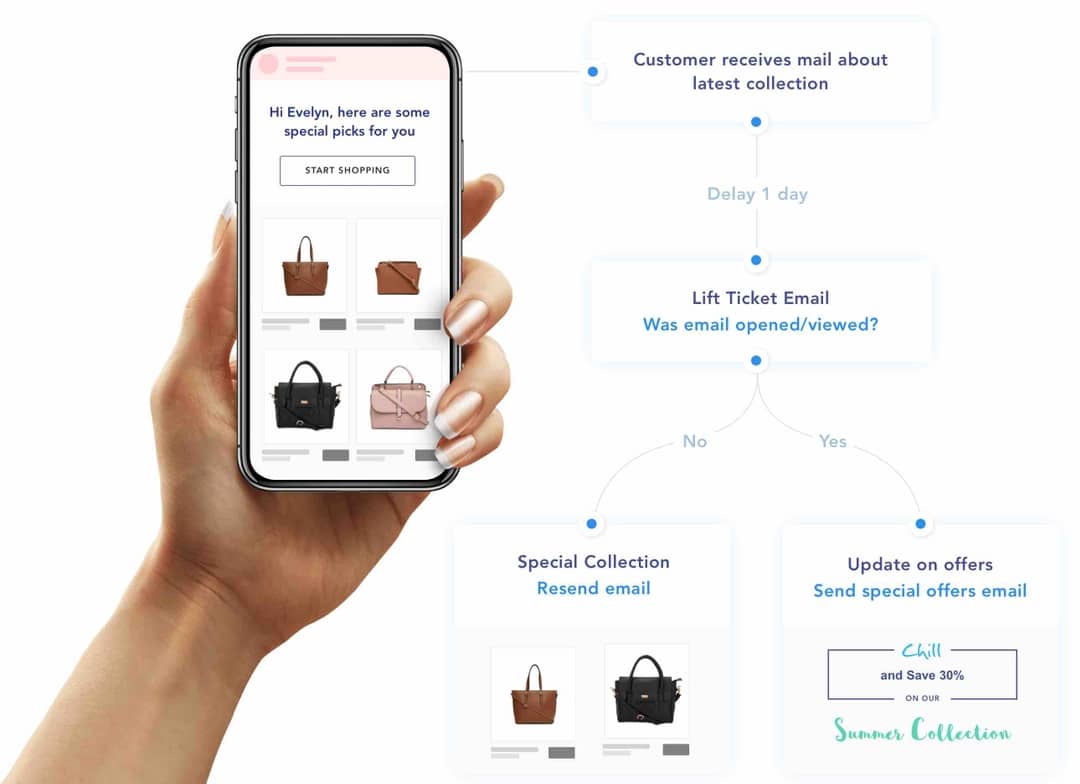
- Set up automated drip emails, so your supporters won’t forget about you even if you fail to send reminder emails manually.
- Optimize emails to look great and be user-friendly on computers as well as smartphones.
- SendX allows unlimited email sends to your opted-in supporters.
- Heatmap reports for your emails for easy campaign analysis.
Bonterra
- Nonprofit CRMs, online fundraising, email marketing, and more, are all under one roof. Bonterra offers a one-stop solution for nonprofits with limited financial or human resources.
- Mobile-optimized layouts that utilize tested best email marketing practices so you get desired results.
- Build supporter segments based on subscribers, major donors, petition signers, interaction history, gift size, location, campaign, and more.
- Direct email donation solicitations for a seamless donor journey.
- Combine email marketing with form builders and social media marketing to avoid missing out on any potential supporters.
Brevo
- Personalization options ranging from as basic as supporters’ names to something as personal as their favorite color. Use these details for high-quality, tailor-stitched email marketing campaigns.
- Brevo has dedicated software for newsletters, so your emails reach the right audience at the right time in the proper format.
- Set up intelligent customer journeys.
Email marketing for nonprofits is all about understanding your leads and nurturing them so they support your cause for an extended period. And like any marketing campaign, this requires intense planning.
Did you know CallHub has email features ready to cater to your nonprofit’s needs? Yes! we do! CallHub email feature lets you personalize, automate, and track messages with just one click and with customisable templates, all in one platform. you can say goodbye to juggling tools and hello to smarter and faster email outreach.
Check out our guide on building an effective marketing plan here: Nonprofit Marketing Plan Template: 9 Simple Steps to Achieve Your Goal.
Feature image: Mohamed Hassan/Pxhere

